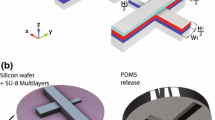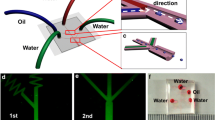Abstract
A single microfluidic chip consisting of six microfluidic flow-focusing devices operating in parallel was developed to investigate the feasibility of scaling microfluidic droplet generation up to production rates of hundreds of milliliters per hour. The design utilizes a single inlet channel for both the dispersed aqueous phase and the continuous oil phase from which the fluids were distributed to all six flow-focusing devices. The exit tubing for each of the six flow-focusing devices is separate and individually plumbed to each device. Within each flow-focusing device, the droplet size was monodisperse, but some droplet size variations were observed across devices. We show that by modifying the flow resistance in the outlet channel of an individual flow-focusing device it is possible to control both the droplet size and frequency of droplet production. This can be achieved through the use of valves or, as is done in this study, by changing the length of the exit tubing plumbed to the outlet of the each device. Longer exit tubing and larger flow resistance is found to lead to larger droplets and higher production frequencies. The devices can thus be individually tuned to create a monodisperse emulsion or an emulsion with a specific drop size distribution.









Similar content being viewed by others
References
Anderson JR, Chiu DT, Jackman RJ, Cherniavskaya O, McDonald JC, Wu HK, Whitesides SH, Whitesides GM (2000) Fabrication of topologically complex three-dimensional microfluidic systems in PDMS by rapid prototyping. Anal Chem 72:3158–3164
Anna SL, Bontoux N, Stone HA (2003) Formation of dispersions using ‘flow focusing’ in microchannels. App Phys Lett 82:364–366
Barbier V, Willaime H, Tabeling P, Jousse F (2006) Producing droplets in parallel microfluidic systems. Phys Rev E 74:046306
Christopher GF, Anna SL (2007) Microfluid methods for generating continuous droplet streams. J Phys D Appl Phys 40:R319–R336
Dijke KCv, Schroe KCPGH, Boom RM (2008) Microchannel emulsification: from computational fluid dynamics to predictive analytical model. Langmuir 24:10107–10115
Dollet B, van Hoeve W, Raven JP, Marmottant P, Versluis M (2008) Role of the channel geometry on the bubble pinch-off in flow-focusing devices. Phys Rev Lett 100
Garstecki P, Hashimoto M, Shevkoplyas SS, Zasonska B, Szymborski T, Whitesides GM (2008) Formation of bubbles and droplets in parallel coupled flow-focusing geometries. Small 4:1795–1805
Kobayashi I, Nakajima M, Chun K, Kikuchi Y, Fujita H (2002) Silicon array of elongated through-holes for monodisperse emulsion droplets. AIChE J 48:1639–1644
Kobayashi I, Wada Y, Uemura K, Nakajima M (2008) Generation of uniform drops via through-hole arrays micromachined in stainless-steel plates. Microfluid Nanofluid 5:677–687
Kobayashi I, Wada Y, Uemura K, Nakajima M (2010) Microchannel emulsification for mass production of uniform fine droplets: integration of microchannel arrays on a chip. Microfluid Nanofluid 8:255–262
Kumacheva E, Li W, Greener J, Voicu D (2009) Multiple modular microfluidic (M(3)) reactors for the synthesis of polymer particles. Lab on a Chip 9:2715–2721
Li W, Young EWK, Seo M, Nie Z, Garstecki P, Simmons CA, Kumacheva E (2008) Simultaneous generation of droplets with different dimensions in parallel integrated microfluidic droplet generators. Soft Matter 4:258–262
McDonald JC, Whitesides GM (2002) Poly(dimethylsiloxane) as a material for fabricating microfluidic devices. Acc Chem Res 35:491–499
McDonald JC, Duffy DC, Anderson JR, Chiu DT, Wu HK, Schueller OJA, Whitesides GM (2000) Fabrication of microfluidic systems in poly(dimethylsiloxane). Electrophoresis 21:27–40
Miller E, Rotea M, Rothstein JP (2010) Microfluidic device incorporating closed loop feedback control for uniform and tunable production of micro-droplets and emulsions. Lab on a Chip 10:1293–1301
Mulligan MK, Rothstein JP (2011) The effect of confinement-induced shear on drop deformation and breakup in microfluidic extensional flows. Phys Fluids 23:022004
Nisisako T, Torii T (2008) Microfluidic large-scale integration on a chip for mass production of monodisperse droplets and particles. Lab on a Chip 8:287–293
Shu L, Eijkel JCT, van den Berg A (2007) Multiphase flow in microfluidic systems—control and applications of droplets and interfaces. Adv Coll Int Sci 133:35–49
van Dijke K, Veldhuis G, Schroen K, Boom R (2009) Parallelized edge-based droplet generation (EDGE) devices. Lab on a Chip 9:2824–2830
Vladisavljevic GT, Williams RA (2005) Recent developments in manufacturing emulsions and particulate products using membranes. Adv Coll Int Sci 113:1–20
Vladisavljevic GT, Kobayashi I, Nakajima M (2011) Effect of dispersed phase viscosity on maximum droplet generation frequency in microchannel emulsification using asymmetric straight-through channels. Microfluid Nanofluid 10:1199–1209
White FM (1991) Viscous fluid flow. McGraw-Hill, New York
Xu SQ, Nie ZH, Seo M, Lewis P, Kumacheva E, Stone HA, Garstecki P, Weibel DB, Gitlin I, Whitesides GM (2005) Generation of monodisperse particles by using microfluidics: control over size, shape, and composition. Angewandte Chemie-International Edition 44:724–728
Acknowledgments
The authors would like to acknowledge the University of Massachusetts Amherst Materials Research Science and Engineering Center for funding this project. We also thank the University of Massachusetts Amherst Center for Hierarchical Manufacturing for use of their cleanroom facilities to fabricate devices.
Author information
Authors and Affiliations
Corresponding author
Rights and permissions
About this article
Cite this article
Mulligan, M.K., Rothstein, J.P. Scale-up and control of droplet production in coupled microfluidic flow-focusing geometries. Microfluid Nanofluid 13, 65–73 (2012). https://doi.org/10.1007/s10404-012-0941-7
Received:
Accepted:
Published:
Issue Date:
DOI: https://doi.org/10.1007/s10404-012-0941-7




